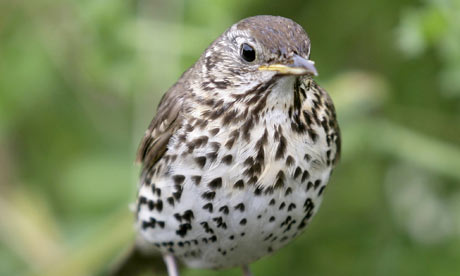
Today Giao Bui and Karesha Lillard presented a Lecture on Sound and Sense and Meter. One of their examples was The Darkling Thrush by THOMAS HARDY 1840–1928. I was curious about the poems form and looked it up. The first link was a reputable, more scholarly and formal site: Poetry Foundation.
http://www.poetryfoundation.org/poem/173590#about
The second was more fun, although the writer knows his or her poetry forms. The language was a lot more informal almost conversational. Certainly if the author's intention was to make poetry forms more accessible to a non scholarly audience, then I believe they are doing a great job. Here is their link: http://www.shmoop.com/darkling-thrush/ I read this in class: http://www.shmoop.com/darkling-thrush/rhyme-form-meter.html
Another interesting note is at: http://www.enotes.com/darkling-thrush The poet wrote this poem at the start of a new century (1900), one he hadn't known he'd see at the old age of 60. Imagine that?! A woman who lives in East Oakland just made 115 this week.
From the London Guardian
"Thomas Hardy's "The Darkling Thrush" was originally called "The Century's End, 1900" and was first printed in The Graphic on 29 December of that year. "A deleted 1899 on the manuscript suggested he had written it a year before," Claire Tomalin tells us in her biography, Thomas Hardy: The Time-Torn Man. Earlier in the same book, Tomalin memorably describes Hardy as a child, waiting each evening for the setting sun to light up the red-painted staircase in the family house, at which point he would recite an "evening hymn" by Sir Isaac Watts, beginning 'And now another day is gone,/ I'll sing my maker's praise.' 'The Darkling Thrush'seems oddly to recall that scene.
"It is one of Hardy's most lyrical poems, musical in execution, metaphor, theme, and even title. The Keatsian word 'darkling' simply means 'in the dark,' but it has the sound of a preludial shimmer of birdsong. Visually, too, it prepares us for the image of the 'aged thrush, frail, gaunt and small,/ In blast-beruffled plume … ' Another use of the -ling suffix is to produce a diminutive of a noun (as in gosling, duckling, sapling, etc.) and though this isn't what is happening etymologically, in 'darkling' we pick up a distant sense of it, and therefore of the bird's littleness and exposedness in his bare tree. . .' (http://static.guim.co.uk/sys-images/Books/Pix/pictures/2009/12/28/1261998406123/A-song-thrush-002.jpg).
Homework is to submit the Poetry Essay. Students were to analyze a poem(s) from Indivisible. Other homework is to start the portfolio narratives. There are 2-3 handouts from Writing with a Thesis and Diana Hacker Rules for Writers (Global Revisions). Bring Hacker to class tomorrow.
In Indivisible we are to read "Public Benefits" (14-15) and follow the assignment on the slip of paper our presenters gave us. Post your comments on the presentation here. What worked well and what you learned. Presenters post your self reflections.
1 comment:
I enjoyed Giao and Karesha's presentation this morning. I thought they were well rehersed. I just wish they'd known more about the poets and the themes, as well as the forms chosen and why for the examples used. I really liked the The Darkling Thrush, which I did not understand initially other than a feeling of gloom. Later after over an hour spent researching the poet and period, I appreciated it more and thought the presenters could have chosen less poems and spent more time on poems like this which covered a lot more than the one mentioned.
Given the overlap of topics, students stayed within the confines of their topic, where what would be better and demonstrated their grasp of the literary terms, would have been if the presenters had built on previous knowledge and talked about other aspects of the poem like speaker/listener, imagery, form, and how these poetic devices augment sound and sense.
Does the sound affect the sensibility of the work? Given Thomas Hardy's influence on the genre of British poetry, one would think from the form to the imagery, sound to lineation, all was purposely chosen for a certain sense or meaning.
I am not certain if I am stalling this time or not. I liked the poem Public Benefits. It is busy with activity.
Assonance is heard in the first stanza lines 14-17:
". . . from the institutes and courts and ledgers
erected in testimony to the countless
births, deaths, and marriages
that bookend out lives" (Hadi 14)
The internal rhymes "tutes, urts" picked up again in the next line with "ted" in erected, "test" in testimony, and the "ths" in births and deaths
Lots of alliteration or initial consonants such as "courts and ledgers. . ." "testimony" and "countless." It is as if the rhyme taking its lead from "court" is split between two words "t" in testimony and "c" in countless; not to mention the assonance or "ou" in "court" and "countless."
Hadi gets a lot of bang for the buck in his slant and internal rhymes like "condensed and reconstituted,/across oceans and rations-lines."
He likes those "s" sounds, those already mention and one that follow in "condensed" and "across" and "oceans" and rations the "ceans" and "tions" ending with the plural form of "lines" lines (19-20).
My favorite lines are in the second stanza:
"We stretch back nylon skin,
dislodge passports and visas,
documents tender as cotton,
folded and refolded like handkerchiefs,
hospital patient cards
stamped like dog-tags" (Hadi 15).
Internal rhymes like the "pit" in hospital and the "pat" in patient. Another is the "ss" in "passports" and "visas". There is also the "is" in "dislodge" and "is" in "visas". Once again the poet is milking his phonemes for all they're worth (smile).
More often than not the sounds are sibilants. Is this a common internal rhyme sound used by English language writers?
He makes the tedious nature of poverty somewhat beautiful.
Post a Comment